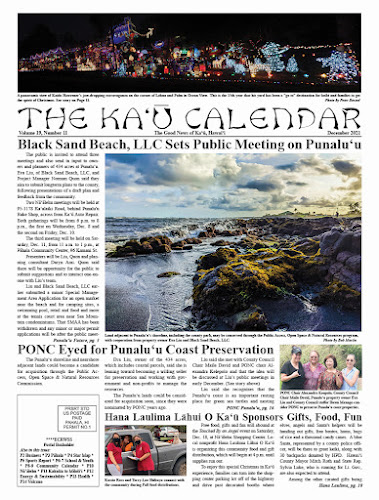
A CATASTROPHIC RAIN EVENT BEGINNING WITH HAWAI'I ISLAND is forecast by National Weather Service, beginning with Hawaii Island on Sunday morning. "Rain events of this size can affect areas that do not usually flood." A Flood Watch, for the State and Island of Hawaii remains in effect through Tuesday. Due to the Flood Watch, conditions are favorable for flash flooding and the followingare
issued by Hawai'i County Civil Defense:
All residents in flood prone areas are asked to remain alert for flooding conditions and to take this time to prepare and address any flooding concerns.
Sandbags will be delivered for active flooding contact Civil Defense at 935-0031.
Remember, if lightning threatens your area, the safest place to be is indoors.
Do not cross fast flowing water in your vehicle or on foot, turn around don't drown.
In addition the following conditions continue: A High Wind Warning and Blizzard Warning for the Summits of Hawaii Island and a Wind Advisory for the rest of Hawai'i Island through Monday.
Due to the Wind Advisory the following are issued: Secure outdoor items; prepare for utility outages.
be aware for debris on roadways and road closures without notice; and limit travel to necessary needs.
High Surf has been upgraded to Warning Levels through Monday for the coastal areas of North Kona, North and South Kohala, Hamakua and Hilo. Expect strong breaking waves, shorebreak, and strong currents making swimming difficult and dangerous.
 |
Read all of The Kaʻū Calendar and back issues at www.kaucalendar.com. Find it in the mail from Volcano through Pāhala, Nāʻālehu, Ocean View to Miloli'i. Pick it up from newsstands. |
Due to the High Surf Warning the following are issued: Secure all property and vessels prior to the arrival of large surf and follow the direction of Ocean Safety Officials.
To read comments, add your own, and like this story, see www.facebook.com/kaucalendar/. See latest print edition at www.kaucalendar.com.
THE NATURE CONSERVANCY is welcoming Makaleʻa Ane to its Hawai'i and Palmyra team as its new Marine Community Program Manager. Ane has more than two decades of experience working with indigenous communities and government agencies on ocean and coastal conservation issues for the public, private and non-profit sectors across Hawaiʻi – including with partners at Puʻu Kukui Watershed Preserve and Coral Reef Alliance.
She most recently served as a County Resilience Officer in Hawai'i, where she was responsible for
bringing together a wide array of partners and stakeholders to build support for and implement climate resilience, adaptation and mitigation initiatives across Maui Nui. In her work, she highlighted the importance of nature-based and indigenous solutions to climate change, the effects of climate change on indigenous practices, and the integration of solutions for nature and people into countywide policy and planning. |
| Makale'a Ane is The Nature Conservancy's new Marine Community Program Manager for Hawai'i and Palmyra. Photo from TNC |
Ane earned her degree in Zoology from Oregon State University before launching her career in environmental research and preservation. She has a diverse background, having worked for the Environmental Protection Agency, National Forest Service, as well as various private and non-profit organizations. Ane also started her own Hawaiian cultural Eco-Tour company creating a network of businesses that promote environmental restoration, cultural revitalization, and sustainable tourism. She also helped found the Living Pono Project, a nonprofit that provides educational resources to K-12 students with an emphasis on perpetuating Hawaiian culture through environmental restoration, as well as post-secondary education, employment opportunities, and everyday living assistance to adults with disabilities.
Scientists at the USGS Hawaiian Volcano Observatory largely rely on aerial data collection for making maps of ongoing eruptions at Kīlauea. Most commonly, scientists collect a series of overlapping aerial photos (optical or thermal).
A technique called structure-from-motion then uses motion parallax to construct a two-dimensional map or three-dimensional model of the area by matching the same features across multiple images.
HVO’s aerial photography is typically done during helicopter overflights, which are limited by budget, weather, and aircraft availability. Since 2018, small unoccupied aircraft systems (sUAS, or “drones”) have augmented the helicopter overflights to some degree, but they have their own limitations as well. While both of these techniques are excellent for making maps and topographic models, understanding some processes requires even more detailed surveys conducted from the ground.
The modern workhorse for ground surveying is terrestrial laser scanning (TLS) using light detection and ranging (LiDAR) instruments. LiDAR may sound familiar to longtime "Volcano Watch" readers, because
TLS surveys work best when there is a substantial amount of topographic relief, providing the instrument with good line-of-sight views of distant features. The current lava lake provides an ideal situation because scanning can be done from the crater rim, looking down on the eruptive features. Both the December 2020–May 2021 and September 2021–present eruptions in Halemaʻumaʻu crater have been surveyed using TLS LiDAR.
HVO does not have a TLS LiDAR instrument of its own to survey the growing lava lake, so some colleagues have lent a helping hand. The team at the U.S. Army Corps of Engineers’ Cold Regions Research and Engineering Laboratory (CRREL)—who had previously collaborated on a TLS study of the 2008-2018 Halemaʻumaʻu lava lake—loaned HVO a TLS LiDAR instrument shortly after the onset of the eruption in December 2020.
CRREL’s LiDAR instrument is a Class 1 laser product, meaning that the laser pulses are safe for the eyes of bystanders and any nearby wildlife (some higher-power instruments require safeguards). For each scan, the LiDAR instrument is set up on survey tripod to rotate through 360 degrees over the course of approximately 15 minutes. These scans produce “point clouds,” which are digital collections of reflection points in three-dimensional space, depicting topographic features.
HVO scientists have completed eight TLS surveys of Halemaʻumaʻu since January. Most of these surveys involve visits to the west and south rims of the crater, for at least one scan from each direction. On two occasions, the instrument has been taken to the edge of the eastern down-dropped block within the 2018 collapse crater, for scans at closer range to the lava lake.
The point clouds from HVO’s TLS surveys at Halemaʻumaʻu have allowed scientists to build high-resolution digital elevation models of the crater and lava lake. The unmatched accuracy can record detailed topography as small as 5 millimeters (0.2 inches), from a distance up to 2.5 kilometers (1.6 miles) away. In comparison, most aerial photography from HVO helicopter overflights will yield a resolution of approximately 1 meter (yard).
LiDAR also avoids misalignment errors that can warp structure-from-motion models and further decrease their accuracy. This is because LiDAR is a “direct” measurement technique, with the laser pulses actually reflecting back from the measured features. In fact, HVO uses the TLS LiDAR data to help calibrate the structure-from-motion datasets for the Halemaʻumaʻu eruptions, improving their accuracy.
HVO hopes to obtain its own TLS LiDAR instrument in the near future, which will open up even more
research possibilities using this technology. But in the meantime, we sincerely thank the team at the Cold Regions Research and Engineering Laboratory for their ongoing assistance in studying the eruptive activity at Kīlauea.
















KAʻŪ COFFEE MILL & VISITOR CENTER. Buy online at kaucoffeemill.com and in person at 96-2694 Wood Valley Road, daily, 9 a.m. to 3 p.m.


COMMUNITY











